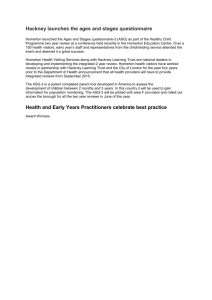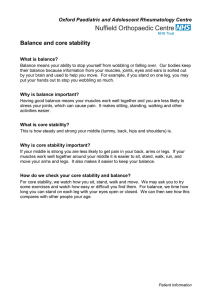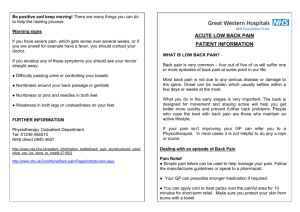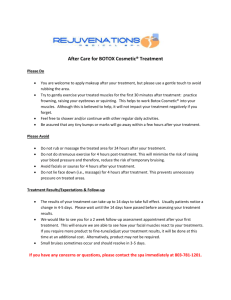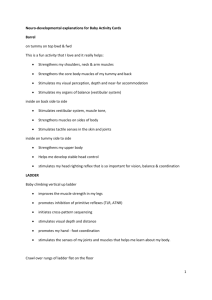Back Care For Pregnant Women (v.3) May 2014
advertisement
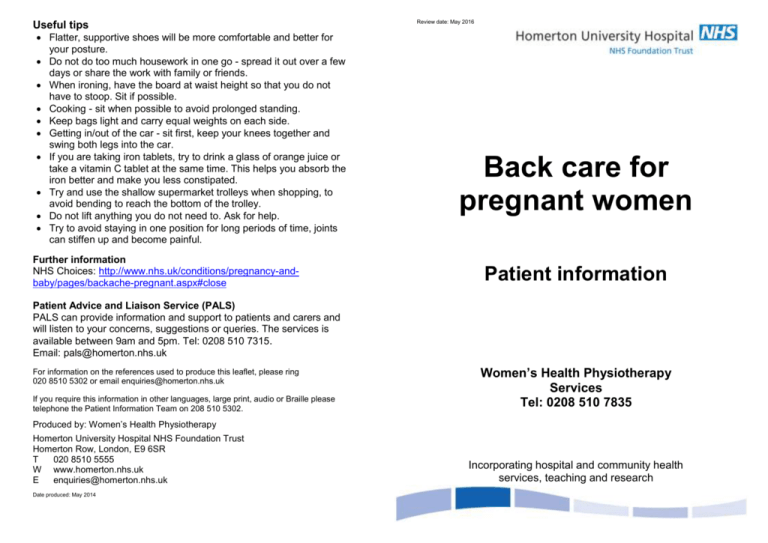
Useful tips Flatter, supportive shoes will be more comfortable and better for your posture. Do not do too much housework in one go - spread it out over a few days or share the work with family or friends. When ironing, have the board at waist height so that you do not have to stoop. Sit if possible. Cooking - sit when possible to avoid prolonged standing. Keep bags light and carry equal weights on each side. Getting in/out of the car - sit first, keep your knees together and swing both legs into the car. If you are taking iron tablets, try to drink a glass of orange juice or take a vitamin C tablet at the same time. This helps you absorb the iron better and make you less constipated. Try and use the shallow supermarket trolleys when shopping, to avoid bending to reach the bottom of the trolley. Do not lift anything you do not need to. Ask for help. Try to avoid staying in one position for long periods of time, joints can stiffen up and become painful. Further information NHS Choices: http://www.nhs.uk/conditions/pregnancy-andbaby/pages/backache-pregnant.aspx#close Review date: May 2016 Back care for pregnant women Patient information Patient Advice and Liaison Service (PALS) PALS can provide information and support to patients and carers and will listen to your concerns, suggestions or queries. The services is available between 9am and 5pm. Tel: 0208 510 7315. Email: pals@homerton.nhs.uk For information on the references used to produce this leaflet, please ring 020 8510 5302 or email enquiries@homerton.nhs.uk If you require this information in other languages, large print, audio or Braille please telephone the Patient Information Team on 208 510 5302. Women’s Health Physiotherapy Services Tel: 0208 510 7835 Produced by: Women’s Health Physiotherapy Homerton University Hospital NHS Foundation Trust Homerton Row, London, E9 6SR T 020 8510 5555 W www.homerton.nhs.uk E enquiries@homerton.nhs.uk Date produced: May 2014 Incorporating hospital and community health services, teaching and research This booklet provides information about the causes of back and pelvic pain during pregnancy. It also contains advice, helpful tips and exercises that will help you manage your pain. Why do women get back pain while pregnant? 2. Posture changes – as baby grows, your tummy muscles will stretch and you will find your back arches more. As your bump gets bigger, you will find that you are learning back more, which can cause back pain. Many changes to the body occur during pregnancy, and many women find this causes them pain. Lower tummy exercise Pelvic floor exercises This exercise strengthens the tummy muscles that support the back. You can do it in any position. The pelvic floor muscles are a group of muscles underneath your pelvis, they act like a sling to support your back and pelvic joints and they control your bladder and bowel. Try pulling the lower tummy in towards your back bone. Imagine you were trying to put on a tight pair of trousers. Try and hold these muscles in gently whilst breathing normally. Try to do this exercise whilst you are sitting or lying to begin with. When it gets stronger you can try doing it in standing and whilst you are lifting. 1. Stomach muscles− as your baby grows, these muscles will stretch, and one set of muscles separates at the front of your stomach to allow the bump to grow. If these muscles are strong it can reduce the risk of having back pain. 3. Hormonal changes – relaxin is hormone that is released in early pregnancy to help soften ligaments and muscles so that baby has room to grow. In pregnancy they are stretched and can weaken, so it is vital to exercise them during and after pregnancy to prevent incontinence or prolapse problems. To do the exercise aim for a lifting or pulling up sensation from underneath your pelvis, as if you are trying to stop passing urine or wind. Do 10 quick pull ups, relaxing well between each one. Then do 10 slow holding squeezes, aim to hold each one for between five to ten seconds. These should be done three to four times a day, every day. Sitting or lying positions are easier. Exercises These exercises can relieve back pain and help prevent it. You should try and do them every day, little and often. Bottom squeezes This can be done in standing, sitting, or lying down. Squeeze your buttocks together, hold for ten seconds and relax. Repeat this exercise ten times. Cat exercise This can be done on all fours. Arch your back up as high as your can, looking downwards. Dip your back down and lift your head at the same time. Repeat 10 times, regularly. Posture Posture in standing Maintaining a good posture is important to minimise the risk of any further back pain. Tighten your tummy muscles and tilt your pelvis backwards, tucking your bottom under, so that you flatten the small of your back. Posture in sitting Make sure your back is supported using pillows or cushions behind you. You may need to roll a small towel up and place it in the small of your back instead. Your feet should be flat on the floor. If they do not reach the floor, put a telephone directory or a block underneath your feet. Gently draw your shoulders back and down, taking a deep breath to relax the neck muscles. Do this regularly whenever you are standing. When you turn in bed, Positions for sleeping Try lying on your side with a pillow under your bump and a pillow between your knees and ankles. squeeze your bottom muscles, bend your knees and keep them together. Alternatively turn under by going on your hands and knees. Getting in and out of bed When you get out of bed, avoid doing a sit up, as this will be very difficult and will put more strain on the muscles at the front of your tummy. Always keep your legs together, bend your knees and roll onto your side. Then use your arms to push up into a sitting position. To get back into bed do the reverse If you want to, you can buy pregnancy pillows which will fit between your knees and under bump. If you have a very firm mattress you may find it more comfortable to lie on top of a duvet. This will soften the bed. Alternatively put a pillow or soft towel under your hip. If you are comfortable lying on your back make sure you put a number of pillows under your head, shoulders and upper back. This will prevent you from lying flat on your back and stop your blood pressure from dropping. If you have any concerns or questions about any of the advice, you can contact the following people. Women’s Health physiotherapy team: 0208 510 7835 Homerton Ante Natal Clinic: 0208 510 7175 Homerton maternity helpline: 0208 510 5955 Alternatively, you can contact your GP.



